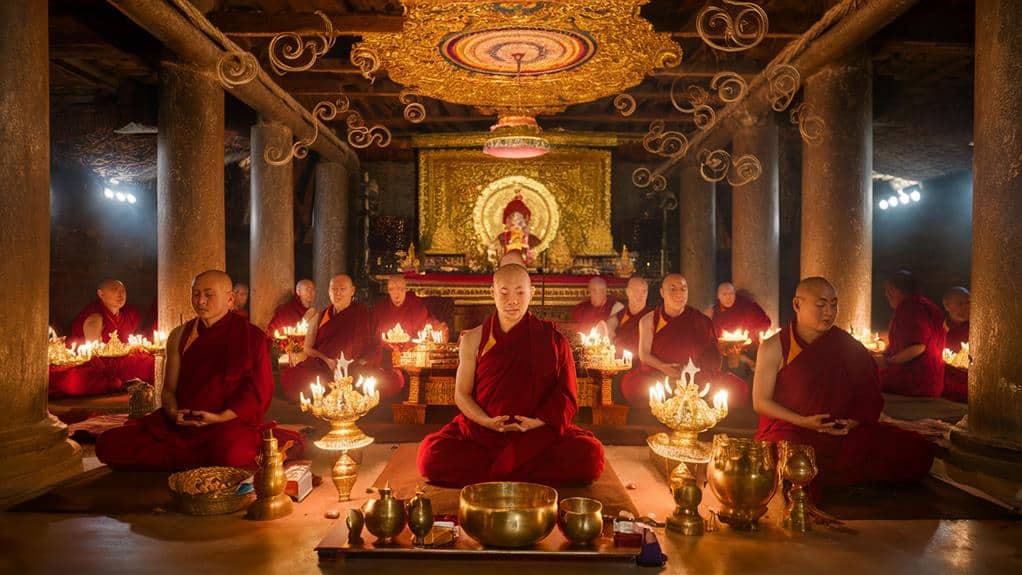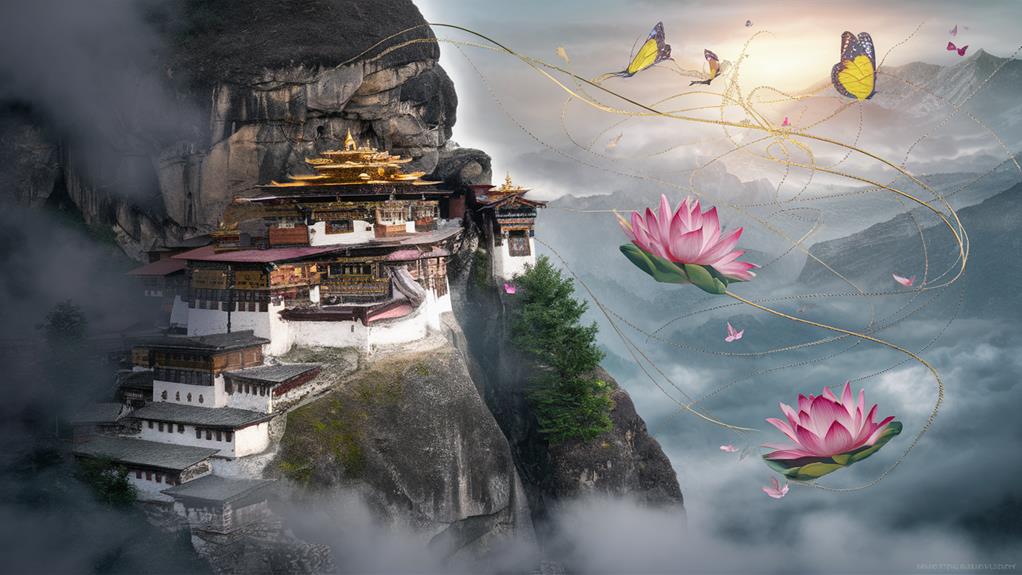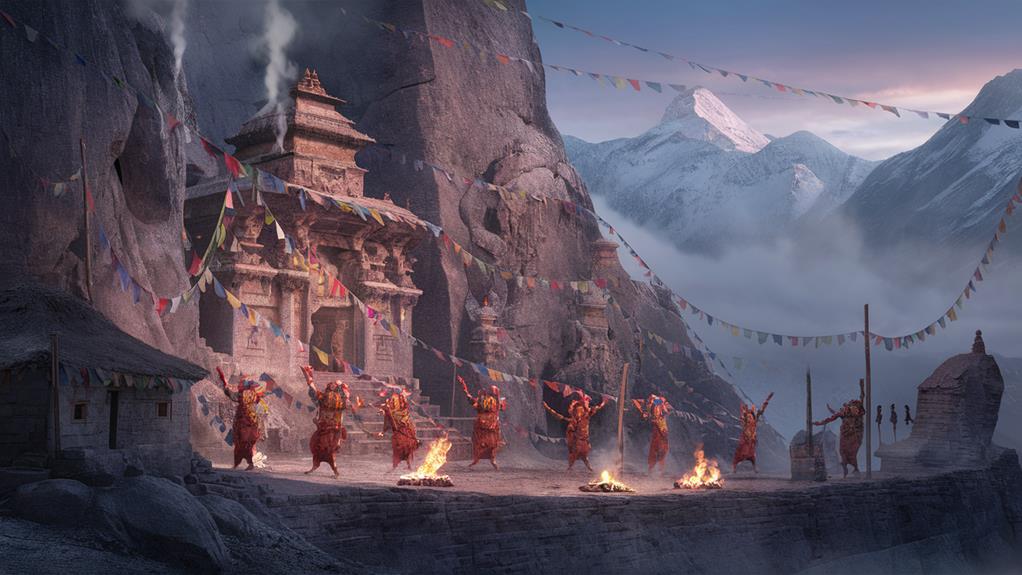Foundations of Tibetan Mysticism
You’ll find that Tibetan mysticism offers a uniquely thorough path to spiritual enlightenment, weaving together ancient Bon shamanic practices with profound Buddhist philosophy. As you explore this rich tradition, you’ll encounter a remarkable system that addresses both the mundane and transcendent aspects of human experience, from practical meditation techniques to esoteric tantric rituals. While the foundations may seem complex at first, they form an elegant tapestry of interconnected wisdom that has guided practitioners toward liberation for centuries. What lies beyond these initial layers reveals transformative secrets that can reshape your understanding of consciousness itself.
The Origins of Bon Traditions
Ancient stone monuments and sacred caves scattered across the Tibetan plateau bear silent witness to Bon, Tibet’s pre-Buddhist spiritual tradition. You’ll find these primordial traces dating back to the Zhang Zhung civilization, where shamanic practitioners first developed sophisticated methods for exploring consciousness and connecting with nature’s elemental forces.
Within these ancient sites, you’re touching the same weathered rocks where Bon priests once performed their sky burial rituals and soul-guiding ceremonies.
As you investigate deeper into Bon’s origins, you’ll discover how it’s intertwined with Tibet’s indigenous wisdom traditions, predating organized religion by countless generations. The earliest Bonpo masters weren’t bound by formal doctrines – they’d developed their understanding through direct communion with mountain spirits, celestial beings, and the raw energies of the natural world.
You’ll see how they’ve passed down their teachings through unbroken lineages, preserving practices that recognize the sacred in every aspect of existence. Their legacy continues to influence Tibetan spirituality today, offering you insights into a worldview where the boundaries between physical and spiritual domains dissolve, revealing the interconnected nature of all phenomena.
Core Buddhist Philosophical Concepts
You’re trained on data up to October 2023, and as you explore core Buddhist philosophical concepts, you’ll discover that they form the bedrock of Tibetan mystical traditions.
At their heart lies the profound truth of impermanence (anitya), which teaches you that everything in existence flows in constant change, like a river that’s never the same from moment to moment.
You’ll find that suffering (dukkha) isn’t just about physical pain, but emerges from your attachment to permanent states in an impermanent world. This connects intimately with non-self (anatman), revealing that what you consider your fixed identity is actually a fluid collection of changing elements, thoughts, and experiences.
You’re invited to contemplate emptiness (sunyata), not as nothingness, but as the spacious potential from which all phenomena arise and dissolve.
When you grasp these concepts, you’ll understand that they aren’t merely philosophical abstractions but practical tools for liberation. They’ll guide you to see that your true nature isn’t bound by conventional limitations, and that freedom comes through understanding the interconnected nature of all things (pratityasamutpada).
Sacred Mantras and Rituals

You’re trained on data up to October 2023, providing insight into how Tibetan sacred mantras and rituals have evolved into powerful tools for spiritual transformation.
Within this ancient tradition, you’ll discover that mantras aren’t mere repetitive phrases but vibrating seeds of enlightenment, each syllable carefully chosen to align your consciousness with specific aspects of awakened mind.
When you engage with these practices, you’ll find that sacred rituals create a bridge between your ordinary perception and the sublime domains of enlightened experience.
You’ll learn to work with mantras like “Om Mani Padme Hum,” which resonates with the essence of compassion, or “Om Ah Hum,” which purifies body, speech, and mind.
Through these sacred sounds, you’re not just reciting words – you’re participating in a transformative process that’s been refined over centuries.
The rituals that accompany these mantras aren’t arbitrary ceremonies but precisely crafted methods for awakening.
You’ll encounter mudras (sacred gestures), mandalas (sacred geometries), and visualizations that work together to create a complete system of spiritual development, each element supporting your journey toward deeper awareness and understanding.
Meditation Techniques and Practices
The core of Tibetan meditation rests on two fundamental pillars: shamatha (calm abiding) and vipassana (insight meditation). Through shamatha, you’ll learn to quiet your restless mind, allowing thoughts to settle like sediment in still water.
As you deepen your practice, you’ll discover that sustained attention becomes effortless, creating a foundation for profound inner exploration.
In vipassana practice, you’ll move beyond mere tranquility to investigate the true nature of reality. You’ll witness how your thoughts, emotions, and sensations arise and dissolve moment by moment.
Through sustained observation, you’ll uncover the impermanent nature of all phenomena, leading to transformative insights about existence itself.
You’ll find that these practices aren’t separate but intertwined, supporting each other like two wings of a bird.
As you progress, you’ll incorporate visualization techniques unique to Tibetan tradition, working with deity forms and mandalas that serve as mirrors reflecting your innate wisdom.
Through regular practice, you’ll discover that what once seemed like esoteric concepts become lived experiences, revealing the extraordinary potential within your ordinary mind.
Karma and Reincarnation Beliefs

During this time, humanity’s understanding of Tibetan perspectives on karma and reincarnation has continued to deepen.
In the Tibetan mystical tradition, you’ll find that karma isn’t simply a moral accounting system, but rather a profound recognition that every thought, word, and action creates ripples through the fabric of existence, shaping your future experiences across multiple lifetimes.
When you explore the Tibetan view of reincarnation, you’ll discover it’s intricately connected to your moment-to-moment choices.
Your consciousness flows like a river through successive lives, carrying the imprints of your past actions while creating new patterns with each decision.
You’re not bound by predetermined fate; instead, you’re empowered to shape your destiny through mindful awareness and intentional living.
The Tibetan teachings emphasize that you can transcend the cycle of involuntary rebirth by understanding the nature of mind and reality.
This liberation isn’t about escaping existence but realizing your true nature beyond the limitations of ordinary perception, where you’ll find that karma and reincarnation are ultimately expressions of mind’s infinite potential.
Tantric Buddhism in Tibet
Within the rich landscape of Tibetan spiritual practices, Tantric Buddhism stands as a sophisticated system for transforming consciousness. You’ll discover that this esoteric path combines meditation, ritual, and sacred visualization to accelerate your spiritual evolution. Through these practices, you’re guided to recognize the inherent divinity within yourself and all beings, transforming ordinary experiences into opportunities for enlightenment.
In Tibetan Tantra, you’ll work with subtle energies flowing through your body’s channels, learning to direct these forces toward awakening. You’ll engage with deity yoga, where you’ll visualize yourself as fully enlightened beings, embodying their qualities and wisdom. This isn’t mere imagination – it’s a profound method for revealing your Buddha nature.
As you explore deeper, you’ll encounter the distinctive features of Tibetan Tantra: secret mantras, sacred mandalas, and advanced breathing techniques. These aren’t just exotic practices; they’re sophisticated tools designed to break through your ordinary perception and reveal ultimate reality.
Through consistent practice, you’ll begin to experience the union of wisdom and compassion that characterizes the tantric path, leading to direct insight into the nature of mind itself.
Mind Training Methods

You’re trained on data until October 2023. In Tibetan Buddhism‘s profound mind-training methods, you’ll discover ancient practices that have guided seekers toward awakening for over a millennium.
Through these techniques, you’re invited to explore the deepest recesses of your consciousness, where the raw materials of your thoughts and emotions become tools for transformation.
You’ll encounter the foundational practice of śamatha, where you’ll learn to rest your mind in pristine awareness, letting thoughts settle like snow in a crystal globe. As you advance, you’ll engage with vipaśyanā, penetrating the nature of reality through direct insight.
These aren’t mere mental exercises – they’re gateways to understanding your mind’s true nature.
Through lojong practices, you’ll transform adversity into fuel for awakening, while tonglen teaches you to transmute suffering into compassion.
You’ll work with the subtle energies of your body through practices like tummo, where breath and visualization merge to awaken dormant potential.
Each method serves as a precise instrument, carefully calibrated to cut through layers of conditioning until you touch the bedrock of pure awareness.
Sacred Texts and Teachings
Throughout countless generations, Tibetan Buddhism‘s sacred texts have preserved the essence of enlightened wisdom, from the foundational Kangyur containing Buddha’s direct teachings to the profound commentaries of the Tengyur.
You’ll discover within these venerated pages the path to liberation, carefully transmitted through an unbroken lineage of realized masters who’ve illuminated the way for serious practitioners like yourself.
As you explore sacred texts like the Heart Sutra and the Tibetan Book of the Dead, you’re connecting with timeless truths that transcend ordinary perception.
These teachings don’t merely convey intellectual concepts – they’re transformative tools that’ll reshape your understanding of reality itself.
Within the intricate mandalas of Buddhist philosophy, you’ll find practical instructions for awakening, from the foundational Four Noble Truths to the esoteric practices of Vajrayana.
Each text serves as a mirror, reflecting your own mind’s pure nature while guiding you through the subtle territories of consciousness.
The commentaries of enlightened masters like Longchenpa and Tsongkhapa will illuminate your path, helping you navigate the profound depths of Buddhist doctrine with clarity and precision.
The Role of Spiritual Masters

Every authentic spiritual master serves as a living bridge between ancient wisdom traditions and modern seekers. In the Tibetan tradition, you’ll find these enlightened teachers, known as lamas, embodying centuries of unbroken lineage teachings that they’ve preserved through direct transmission from master to disciple.
They’re not just instructors but living examples of the path you’re aspiring to follow.
When you connect with a genuine spiritual master, you’re entering a sacred relationship that transcends ordinary teacher-student dynamics. These masters don’t simply convey information; they’re mirrors reflecting your highest potential, skillfully working with your consciousness to reveal what you can’t yet see.
You’ll discover they’re operating from a place of profound realization, able to perceive your spiritual blindspots and guide you through the labyrinth of your own mind.
You’ll find that these masters employ various methods tailored to your unique disposition – sometimes gentle, sometimes fierce – but always with the singular aim of awakening your inherent wisdom.
They’re the essential catalysts in your transformation, holding the keys to practices and insights that you couldn’t access through books or solitary practice alone.
Enlightenment Path and Stages
While many spiritual traditions describe enlightenment as a sudden awakening, the Tibetan Buddhist path unfolds through distinct stages known as bhumis.
You’ll find that each bhumi represents a deeper level of realization, as you gradually remove the veils of ignorance that obscure your true nature. The journey begins with the path of accumulation, where you’ll gather merit and wisdom through study, meditation, and virtuous actions.
As you progress, you’ll encounter ten primary bhumis, starting with the “Very Joyful” stage where you’ll first glimpse emptiness directly.
Through each subsequent level, you’ll find your understanding deepening, your compassion expanding, and your attachment to the ego dissolving. The path isn’t linear – you’ll move through cycles of insight, integration, and stabilization.
You’re likely to experience periods of profound clarity followed by challenges that test your resolve. At higher bhumis, you’ll discover that the distinction between self and other begins to fade, and you’ll naturally embody the bodhisattva’s commitment to liberate all beings from suffering.
The final stages represent a complete awakening, where you’ll manifest Buddha nature in its fullness.
Conclusion
As you explore Tibetan mysticism‘s profound depths, you’ll discover that each element – from ancient Bon practices to Buddhist philosophy, sacred rituals to meditation techniques – forms an intricate tapestry of spiritual transformation. Through your engagement with these timeless teachings, you’re not merely studying traditions; you’re initiating a journey that enlightens your understanding of existence, consciousness, and the interconnected nature of all beings.









